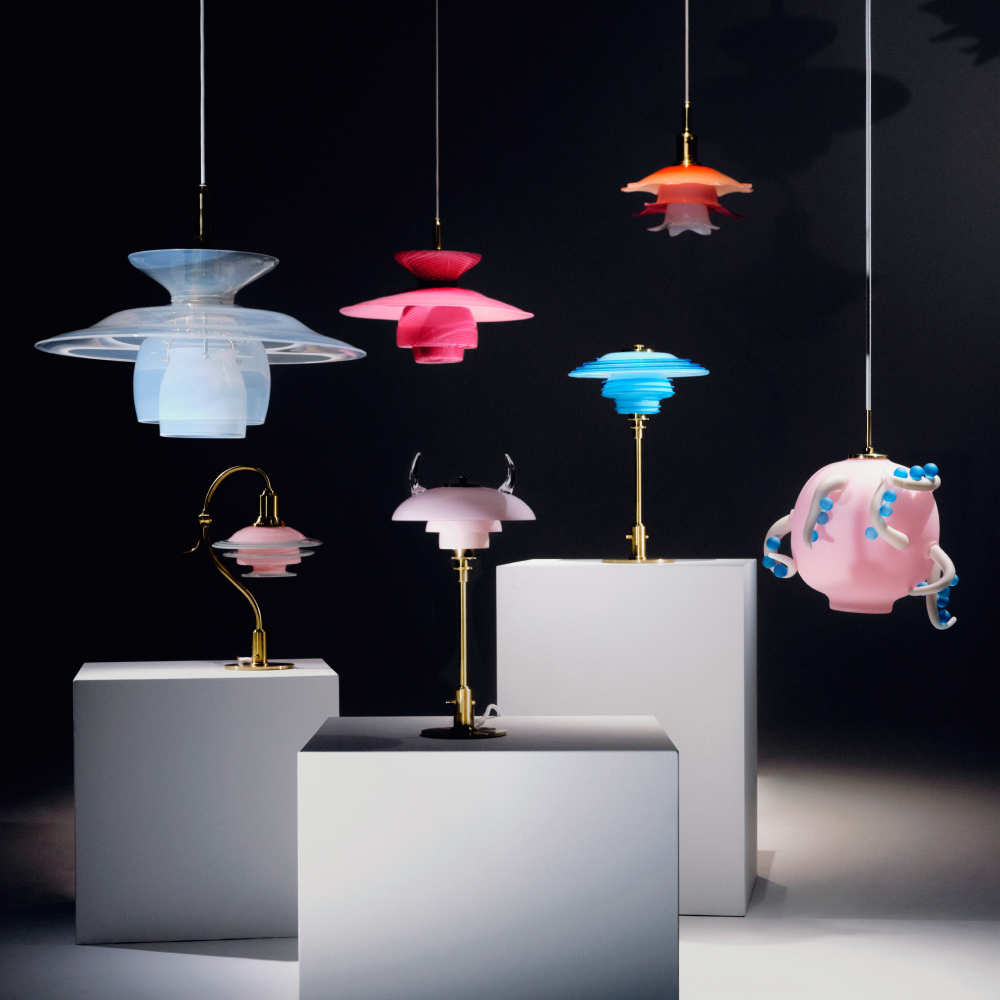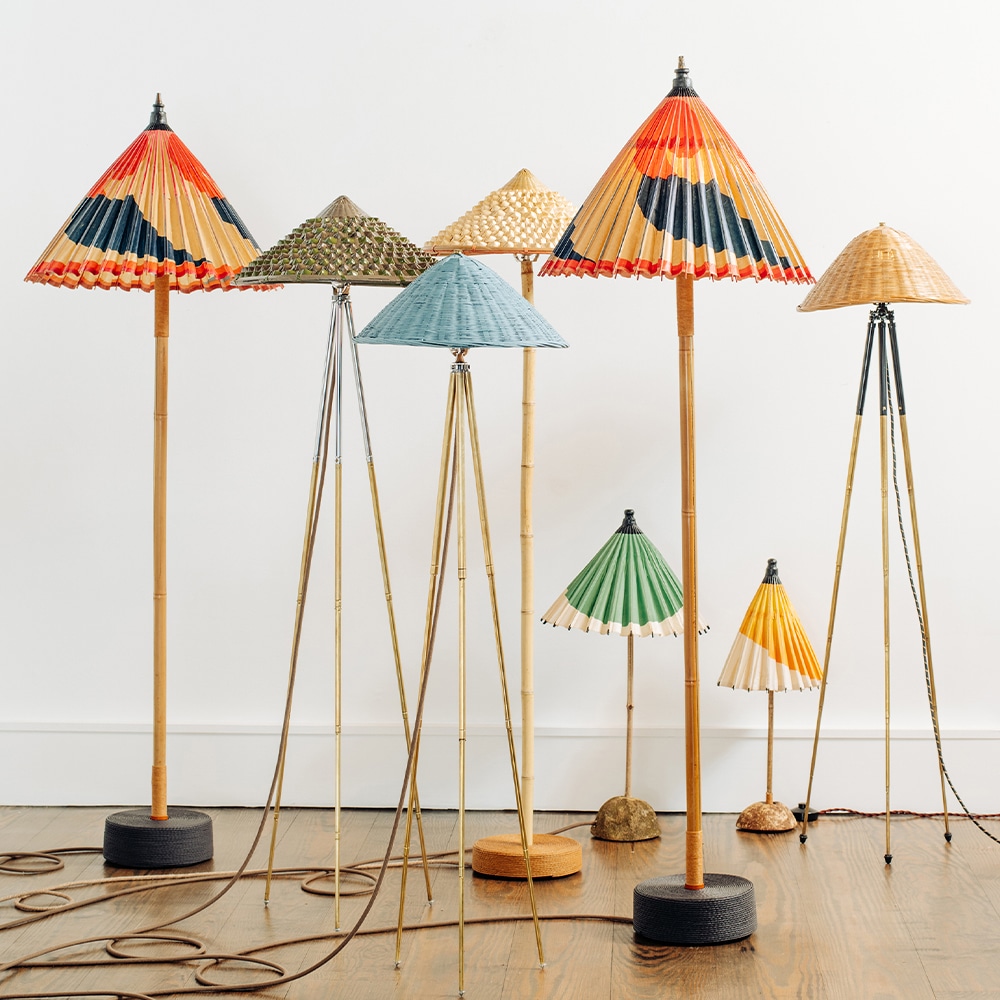
April 17, 2013Bonetti stands next to one of his boldest new creations: the Liquid Gold cabinet, 2012, made of cast aluminum that looks like wood grain, with translucent pink rock crystal borders and gold-plated bronze decorations. Photo by Billy Farrell, BFAnyc.com.
It’s clear that Mattia Bonetti is a design polyglot, embracing styles from neo-Baroque to minimal, organic to geometric. Since the early 1980s, when he partnered with Elizabeth Garouste, and on through the 2000s (he went solo in 2002), the Swiss-born, Paris-based designer has garnered a large following for his witty, limited-edition furniture creations. Among them: couches wrapped in bronze vines, acrylic cabinets encased in brass stalactites, consoles with legs that mimic pearl necklaces and silvery dining tables with pink tree-trunk bases. Over the years, his avid collectors have included Yves Saint Laurent; Gloria, Princess of Thurn and Taxis; Philip Johnson; Reed Krakoff; art dealer Rachel Lehmann and many others.
But then there are the sleek creations he has unveiled at New York’s Paul Kasmin Gallery for its new show, “Indoor/Outdoor” (through May 4). These include simple, square Lucky Dice stools in shiny stainless steel with dark domino dots and the Metals coffee table, whose glass top reveals a geometric, almost-Mondrian-inspired base of rectangular blocks coated in shimmering nickel, copper and gold finishes.
These pieces prove, once again, that Bonetti is difficult to classify. But why even try to pigeonhole him? He takes inspiration from everywhere — ancient Greece, the Indian subcontinent, children’s toys, blue jeans, radio frequencies and UFOs. Plus, he’s the son of two antiques dealers and has his design history down cold.
“He is a huge talent, a really incredible creator,” says the Paris-based decorator Jacques Grange, who has known Bonetti for decades, personally collecting his work and often commissioning pieces for private and commercial clients, including the Mark Hotel in New York. “He never repeats himself,” Grange says. “He is the definition of cultivated.”

A 2011 exhibition at Michael S. Smith’s Los Angeles gallery, Duke & Duke, featured, among other objects, Bonetti’s Tokyo coffee table and Broken Pearl Necklace desk, both in foreground.

From top: the rendering and the realization of Bonetti’s new cast-bronze Rattan armchair and table, 2012.
A superb draftsman and gifted sculptor, Bonetti often fashions small terra-cotta models of his pieces to study in 3-D before they go into production, and he makes art photography, too. So what does the man himself say about reconciling his various styles? Well, as he told the writer Adrian Dannatt in the 2010 monograph Mattia Bonetti (spearheaded by Krakoff and published by Skira Rizzoli), “I hate the idea of a ‘collection,’ where every piece has a prescribed relationship to each other. That’s not how life is.”
Among the new pieces at Kasmin is an outdoor chair in cast bronze that looks like rattan. Some time ago Bonetti went to Lake Como, Italy, to re-visit the Vittorio Bonacina factory, a renowned wicker furniture factory founded in 1887 that had previously done custom furniture for him. He was so impressed with the elegance of the woven rattan he decided to design a “rattan” chair, table and couch — but in cast-and-patinated bronze that mimics rattan.
“Each piece is separately cast and then reassembled,” explains Nicholas Olney, director of the Paul Kasmin gallery. “Mattia loves working with artisans, and he always tries to do something unexpected.” Bonetti explains: “I’m hit by an idea, and then things work progressively. I go from one piece to the next, following the same idea. It’s a chain.”
Bonetti employs incredibly luxurious materials —Madagascar rock crystal, gold leaf, cast bronze, nickel plate, travertine marble — and assembles them in unlikely combinations. “I like to bring together materials that are very opposite,” he says. “The juxtaposition makes the character of each one strong.”
One shiny new sconce comprises a foot-wide circle of nickeled metal, sheathed in veined white rock crystal and then encircled by more rock crystal in a transluscent-pink band. (Olney says the sconces take some time to make; they have to quarry the crystal in Madagascar and cut it into thin slices before shipping it to the fabricators.)

New for 2013, clockwise from top: The DJ wall sconce, in smoke and clear rock crystal; the Lucky side table-cum-stool in polished stainless steel; the colorful Pliniana armchair

The artist’s original rendering of the cabinet
Bonetti’s new Liquid Gold cabinet, meanwhile, uses cast aluminum to create an imitation of the raised grain of hand-milled elm. He frames this with rock crystal and embellishes it with gilded-bronze mounts (feet, door pulls, ameboid decorations) that look like molten lava. “I’m interested in the idea of extreme glamor, but with quality,” says the tall, lanky and youthfully handsome 60-year-old. He works with überskilled craftsmen in Switzerland, Italy, France and New York, including wood carvers, gilders, upholsterers, metal workers and Diego Giacometti’s former blacksmith.
Educated at the Centro Scholastico per L’Industria Artistica, in Lugano, Switzerland, Bonetti worked as a textile designer and art photographer before moving to Paris, where he married his wife and raised two children. He first paired up with his design collaborator Garouste in 1980 to decorate the popular Studio 54-like Paris disco Le Palace. The following year, the duo did a so-called “primitive” furniture collection with the Jansen house of interiors. But they didn’t achieve international acclaim until 1987, with the smash debut of their design for couturier Christian Lacroix’s “Maison de Couture” on the Faubourg St. Honore. There, tufted-velvet chairs in orange, lime green and pink sprouted iron horns; overscaled couches seated 10; and the orange rugs, hot-pink walls and iron-mask light fixtures gave off a fiery look. It was baroque, luxurious — and entirely new. The ensuing media attention put Bonetti and Garouste on the map, leading to art gallery shows and several private commissions, many from clients of Jacques Grange.
“Mattia is unencumbered by history. The traditions of form, functionality and materials gracefully acquiesce to his vision.” — Reed Krakoff

At the Kasmin show, a pair of carved-wood Iris chairs flank a Scuba console table in cast-bronze, with an Archetype table lamp atop it. Photo courtesty of Billy Farrell/BFAnyc.com
As Reed Krakoff wrote in the 2010 monograph: “Mattia is unencumbered by history; the traditions of form, functionality and materials gracefully acquiesce to his vision.”
In 1985, Bonetti began to work with the Paris gallery Neotu. By 1988, he was also working with the David Gill gallery in London, which continues to represent him. Through the decades, his work has also been shown in such museums as the Museum of Modern Art, in New York; the Victoria and Albert, in London; and the Centre Pompidou, in Paris.
For the current show, Bonetti has made a large assortment of new tables, chairs, light fixtures, planters, outdoor furniture and ceramic objects. “When I am preparing a show, I try to make one of each so people have as wide a choice as possible,” he says. “I don’t do a collection but a group of objects.”
“I’m a workaholic,” he admits. “I have a little office; it’s just myself and an assistant.” When asked why he doesn’t delegate more, he responds, “Why would I? I love my work.”
Shop Mattia Bonetti on 1stdibs


